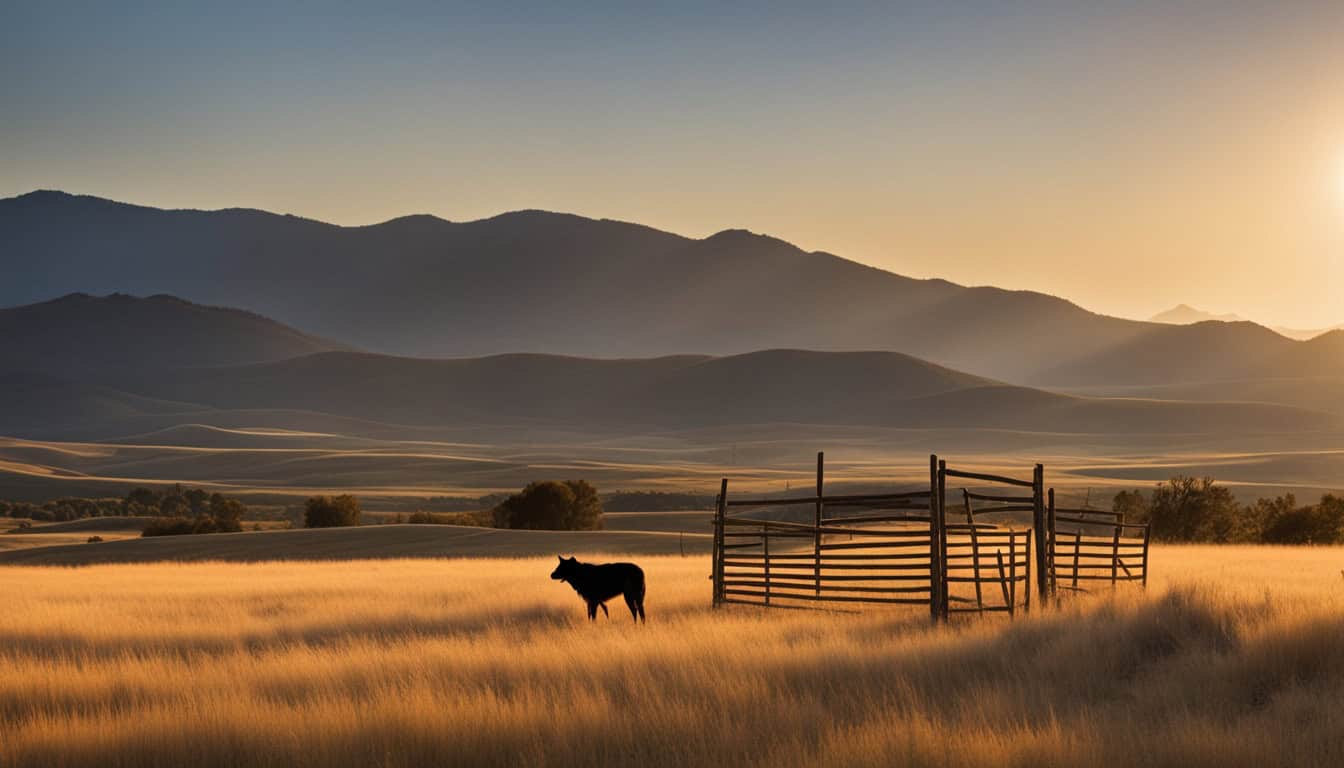Livestock predation is a big issue in the USA, especially with more cases in the East. This is because predators like coyotes are moving into new territories. To protect livestock, first, we need to know what dangers they face. It’s key to spot when and how we lose livestock. This info helps us build focused ways to keep them safe from American predators.
Keeping livestock safe from US predators needs several steps. You should mix prevention with active management. Knowing how predators act and using many ways to protect the livestock is essential. This ensures your animals are safe and can keep producing.
Challenges of Defending Livestock from Predators in the United States
Defending livestock from predators in the United States is tough. The economic losses can be huge. It’s vital to find ways to protect livestock and control these expenses.
One key method for livestock predator protection is through detailed management programs. These programs help save livestock and cut economic losses. With government and cooperative help, they become even more effective for farmers.
Farmers can use smart and affordable methods to control predators. These methods not only keep livestock safe but also help the economy. They benefit the agricultural world in many ways.
| Challenge | Solution | Economic Impact |
|---|---|---|
| High Predator Numbers | Comprehensive Control Programs | Reduced Livestock Losses |
| Limited Resources | Government Funding | Improved Cost-Benefit Ratio |
| Wide Geographic Spread | Cooperative Efforts | Boosted Economic Activity |
Effective Livestock Predator Control Methods
It’s crucial to control predators to lower livestock losses. Knowing common predators and spotting them early are key. This ensures the best protection for your livestock in the USA.
Identifying Common Predators
First, know the predators that often harm livestock in the USA. These can include coyotes, bobcats, mountain lions, and wolves. Recognizing these animals and knowing their habits helps you protect your livestock better.
- Coyotes: They go for young or solitary animals and cover large areas.
- Bobcats: Aim for smaller animals, such as goats and sheep, when not guarded.
- Mountain Lions: Pose a danger to bigger animals, especially near mountains.
- Wolves: Threaten cattle and sheep mostly in the northern states.
The Importance of Early Detection
Spotting predators early is vital for safeguarding your livestock. Watching for changes in livestock behavior and noticing tracks can help. Understanding when and how predators hunt lets you set up defenses, like better fences or guard animals, effectively.
In conclusion, knowing your predators and catching them early cuts down on losses. So, by using these approaches, you make your livestock safer and more secure.
Benefits of Guardian Animals for Livestock Protection
Guardian animals like dogs, llamas, and donkeys are great for keeping predators away. They protect livestock and reduce stress. This can make animals healthier and more profitable.
When picking a guardian animal, think about your farm’s needs and the predators in your area. Each type has its own strengths. Dogs are loyal and protect well. Llamas scare off canines, so they’re good where wolves are. Donkeys are aggressive with predators, perfect for mixed farms.
- Dogs: They protect by forming close bonds with the livestock. Their loyalty helps keep predators away.
- Llamas: Llamas don’t like canines, making them good against wolves and coyotes.
- Donkeys: They’re territorial and fight predators well, especially on mixed farms.
Choosing the right guardian helps a lot. It makes your farm safer from American predators. Using these methods can boost your farm’s productivity and money-making.
Innovative Fencing Solutions for USA Livestock Predator Prevention
Using new fencing methods is key to keeping your animals safe. These ways not only scare off threats but also make your place more secure. This is good for looking after your animals.
Mesh Wire Electric Fencing
Mesh wire electric fencing mixes wire mesh with electric shocks. Predators are deterred by the electric shock. Also, they can’t get past the tight mesh. This makes electric fencing a smart pick for better livestock safety.
Living Fences
Living fences are a green choice over usual fence materials. They’re made by planting thick rows of thorny or quick-growing plants. Besides acting as a strong barrier, they make your farm look nicer. Adding a living fence makes it harder for predators to get in.
Motion-Activated Lights and Alarms
Motion-activated deterrents like lights and sirens are also great. They sense movement by your animals and then turn on bright lights or loud sirens. This surprises predators, making them run off. These tools give you peace of mind and quickly deal with any danger.
Adding innovative fencing solutions such as mesh wire electric fencing, living fences, and motion-activated deterrents works well. It boosts your animals’ protection and keeps predators away.
| Fencing Type | Advantages |
|---|---|
| Mesh Wire Electric Fencing | Dual deterrent effect with physical and electric barrier |
| Living Fences | Eco-friendly, aesthetic, natural barrier |
| Motion-Activated Deterrents | Startle effect with lights and alarms |
How do you protect livestock from predators in the USA?
Keeping your livestock safe involves using many different methods. You can have dogs, llamas, or donkeys protect your animals from predators. This is great for keeping coyotes, wolves, and mountain lions away.
It’s also important to make sure your animals have safe places to stay. Protected shelters especially at night help a lot. Putting up strong fences and enclosures will make your animals even safer.
Changing the environment to be less attractive to predators is smart. You can do this by removing food sources and changing the land. Using lights and alarms that turn on when a predator is near also helps.
It’s a good idea to make sure there’s plenty of food for predators nearby. If they have a lot to eat in the wild, they’re less likely to go after your animals. Creating homes for animals like rabbits keeps predators busy elsewhere.
In short, protecting livestock in the USA means using many strategies together. You need guardian animals, safe places for your animals, and ways to deter predators. Making sure there’s food for predators in the wild also helps. By doing all of this, you make your livestock much safer.
The Role of Agricultural Practices in Safeguarding Livestock
Using smart farming methods can make your animals safer. You can learn where predators go and adjust your farm layout to keep them away. This lets you protect your animals better.
Rotating Grazing Areas
Rotational grazing is when you move animals between pastures. This confuses predators, making it hard for them to hunt. Frequently changing fields keeps your animals safer from attacks.
Timing of Livestock Births
Breeding animals at the right time helps avoid when predators are most active. Knowing when local predators hunt lets you choose safer times to have baby animals. This lowers the chance of them being hunted.

Strategic Placement of Pig Pens
Putting pig pens near people or using fences can keep predators away. This tactic helps keep an eye on your pigs, making them less likely to be attacked. It’s a key way to protect your animals from predators.
Providing Secure Housing for Livestock at Night
Keeping your animals safe from night predators is crucial. Especially young animals need more protection.
Adding electrified fences to your enclosures helps a lot. It stops wild animals from reaching your livestock at night.
Thinking about secure livestock housing? Here are some important points:
- Durable materials for walls and fences
- Proper ventilation to ensure animal health
- Sturdy locks and gates to prevent unauthorized access
- Integrating electrified fencing for additional protection
| Feature | Benefit |
|---|---|
| Electrified Fencing | Offers a high level of nocturnal predator protection |
| Durable Material | Ensures long-lasting and effective secure livestock housing |
| Proper Ventilation | Maintains animal health while providing security |
| Sturdy Locks | Prevents unauthorized or accidental entry |
Include these tips to boost your animals’ safety. This way, they will be well-protected at night. Start modifying this section
Using Disruption Tactics to Manage Predator Behavior
Using behavior disruption tactics is key to controlling predator actions. By moving your animals often, you can make it hard for predators to follow them. This reduces the chances of the livestock being attacked.
It’s also important to fix any ways predators can get in. They look for weak points in fences and shelters. Checking these areas regularly and fixing any problems quickly can help keep predators away.
Using several strategies together works well too. For example, moving livestock and adding things like lights that turn on when something moves can make managing predators even better.
Let’s look at the effectiveness of these tactics:
| Disruption Tactic | Effectiveness | Implementation Ease |
|---|---|---|
| Changing Livestock Locations | High | Medium |
| Repairing Entry Points | High | High |
| Using Sensory Deterrents | Medium | Medium |
Using a mix of these behavior disruption tactics is very helpful. It keeps your animals safe from predators.
Importance of Maintaining a Healthy Prey Population
Keeping prey like rabbits and small mammals healthy is key for your livestock’s safety. When these animals do well, predators might not go after your livestock. You should make your land a good place for wild prey by keeping natural areas and not interfering too much.
A lot of different prey gives you a strong, natural defense against predators. Predators often choose the easiest meal. If there’s lots of wild prey, your livestock is safer. So, it’s important to make sure these animals have what they need to survive.
Helping wildlife on your land is good for your farm and the environment. Things like planting native plants and avoiding harsh chemicals help prey animals. When you support these animals, you’re farming responsibly and taking care of your livestock at the same time.
FAQ
How do you protect livestock from predators in the USA?
To protect livestock in the USA, use a complete plan. This includes guardian animals and safe spaces. Also, use strong fences and action plans to confuse predators. Make sure the natural prey is healthy too, so predators look elsewhere for food.
What are the challenges of defending livestock from predators in the United States?
It’s hard to keep livestock safe in the US. Especially in the East where predators like coyotes are spreading. This causes a big loss for farmers. So, finding good ways to control predators is very important.
How can you identify common predators?
To spot common predators, look for signs early. Learn their habits and when they are active. This will help plan how to protect your animals better.
Why is early detection important in predator management?
Spotting predators early is key. It means you can act fast to protect your animals. Knowing about the predators helps you prepare well against them.
What are the benefits of using guardian animals for livestock protection?
Dogs, llamas, and donkeys are great for scaring off predators. They make your animals less stressed, healthier, and more valuable. But, pick the right one for your farm and its needs.
What are some innovative fencing solutions for USA livestock predator prevention?
New fencing includes electric mesh, living hedges, and alarms. They keep predators out and your animals safe. Use these to prevent attacks on your livestock.
How do agricultural practices help in safeguarding livestock from predators?
Changing how you farm can help keep animals safe. Like moving them around, timing births right, and placing pens carefully. This knowledge keeps predators away and your animals secure.
What measures can be taken to provide secure housing for livestock at night?
Make sure your animals are safe at night. Use shelter that’s secure, especially for babies. Adding electric fences can keep night hunters away.
How can disruption tactics help manage predator behavior?
Change how and where your animals are, fix fences, and close holes. This can stop predators from coming back. They might move on to find food elsewhere.
Why is maintaining a healthy prey population important in predator management?
Having lots of wild prey keeps predators from attacking your livestock. Make spaces for animals like rabbits to live, so predators have other things to eat. This keeps your animals safer.







